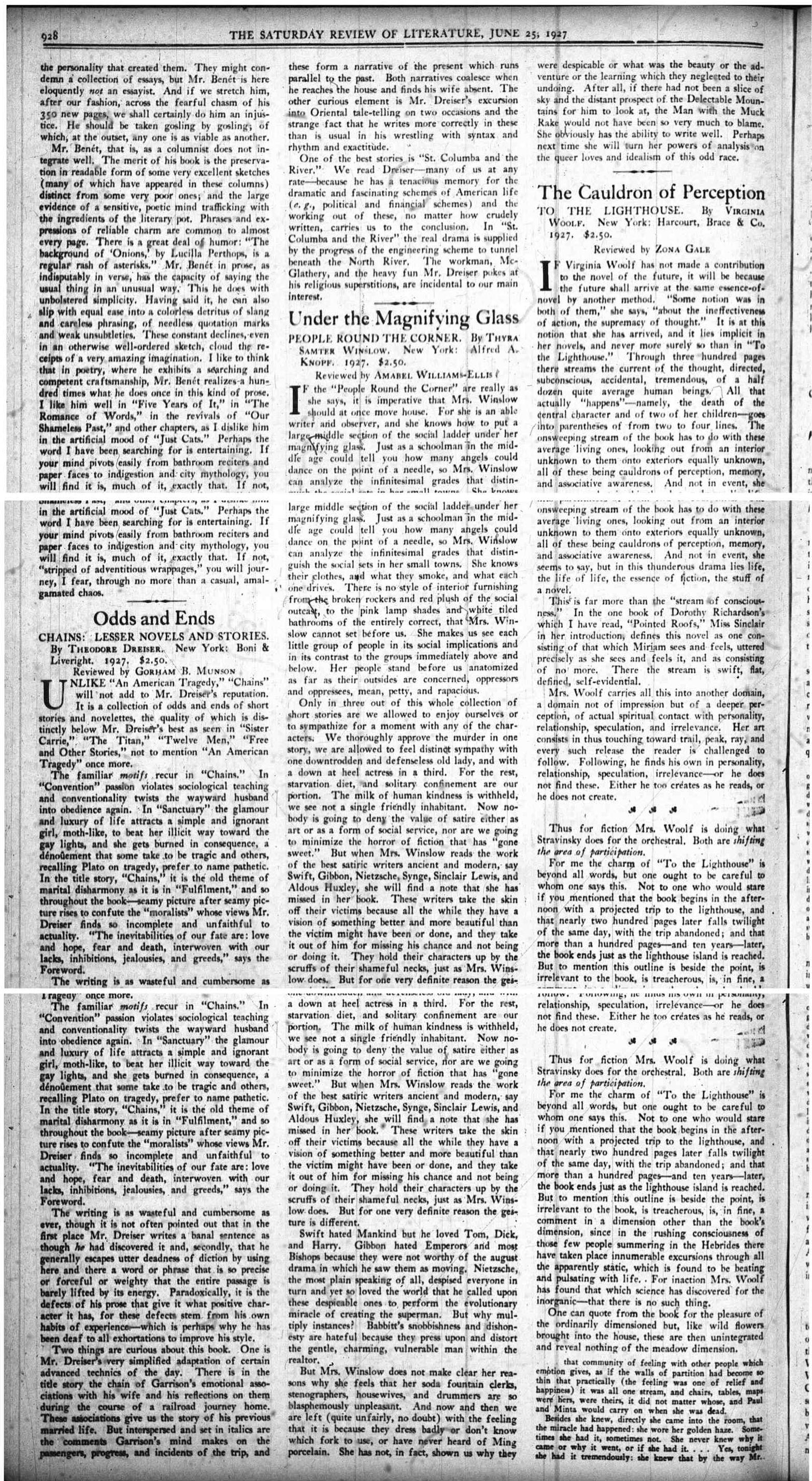
Zona Gale, “The Cauldron of Perception.” The Saturday Review of Literature. June 25, 1927,
pp.928-929.
The Cauldron of Perception
TO THE LIGHTHOUSE. By VIRGINIA
WOOLF. New York: Harcourt, Brace & Co.
1927. $2.50
Reviewed by ZONA GALE
IF Virginia Woolf has not made a contribution
to the novel of the future, it will be because
the future shall arrive at the same essence-of-
novel by another method. “Some notion was in
both of them,” she says, “about the ineffectiveness
of action, the supremacy of thought.” It is at this
notion that she has arrived, and it lies implicit in
her novels, and never more surely so than in “To
the Lighthouse.” Through three hundred pages
there streams the current of the thought, directed,
subconscious, accidental, tremendous, of a half
dozen quite average human beings. All that
actually “happens”—namely, the death of the
central character and of two of her children—goes
into parentheses of from two to four lines. The
onsweeping stream of the book has to do with these
average living ones, looking out from an interior
unknown to them onto exteriors equally unknown,
all of these being cauldrons of perception, memory,
and associative awareness. And not in event, she
seems to say, but in this thunderous drama lies life,
the life of life, the essence of fiction, the stuff of
a novel.
This is far more than the “stream of consciousness.”
In the one book of Dorothy Richardson’s
which I have read, “Pointed Roofs,” Miss Sinclair
in her introduction, defines this novel as one consisting
of what Miriam sees and feels, uttered
precisely as she sees and feels it, and as consisting
of no more. There the stream is swift, flat,
defined, self-evidential.
Mrs. Woolf carries all this into another domain,
a domain not of impression but of a deeper perception,
of actual spiritual contact with personality,
relationship, speculation, and irrelevance. Her art
consists in thus touching toward trail, peak, ray, and
every such release the reader is challenged to
follow. Following, he finds his own in personality,
relationship, speculation, irrelevance—or he does
not find these. Either he too creates as he reads, or
he does not create.
* * *
Thus for fiction Mrs. Woolf is doing what
Stravinsky does for the orchestral. Both are shifting
the area of participation.
For me the charm of “To the Lighthouse” is
beyond all words, but one ought to be careful to
whom one says this. Not to one who would stare
if you mentioned that the book begins in the afternoon
with a projected trip to the lighthouse, and
that nearly two hundred pages later falls into twilight
of the same day, with the trip abandoned; and that
more than a hundred pages—and ten years—later,
the book ends just as the lighthouse island is reached.
But to mention this outline is beside the point, is
irrelevant to the book, is treacherous, is, in fine, a
comment in a dimension other than the book’s
dimension, since in the rushing consciousness of
those few people summering in the Hebrides there
have taken place innumerable excursions through all
the apparently static, which is found to be beating
and pulsating with life. For inaction Mrs. Woolf
has found that which science has discovered for the
inorganic—that there is no such thing.
One can quote from the book for the pleasure of
the ordinarily dimensioned but, like wild flowers
brought into the house, these are then unintegrated
and reveal nothing of the meadow dimension.
… that community of feeling with other people which
emotion gives, as if the walls of partition had become so
thin that practically (the feeling was one of relief and
happiness) it was all one stream, and chairs, tables, maps
were hers, were theirs, it did not matter whose, and Paul
and Minta would carry on when she was dead.
Besides she knew, directly she came into the room, that
the miracle had happened: she wore her golden haze. Sometimes
she had it, sometimes not. She never knew why it
came or why it went, or if she had it…. Yes, tonight
she had it tremendously: she knew that by the way Mr.






